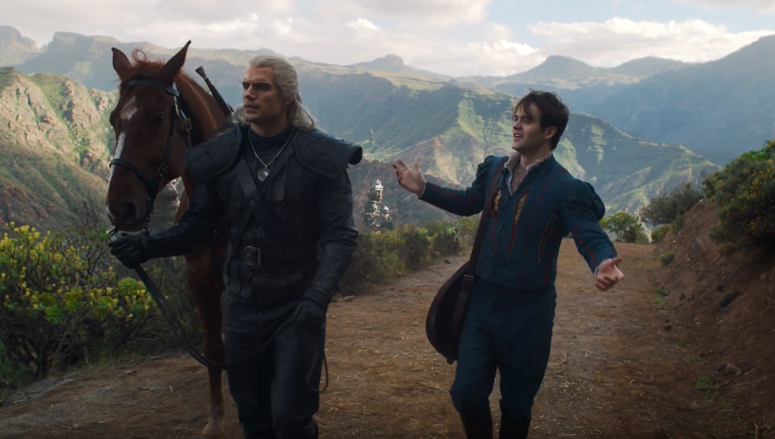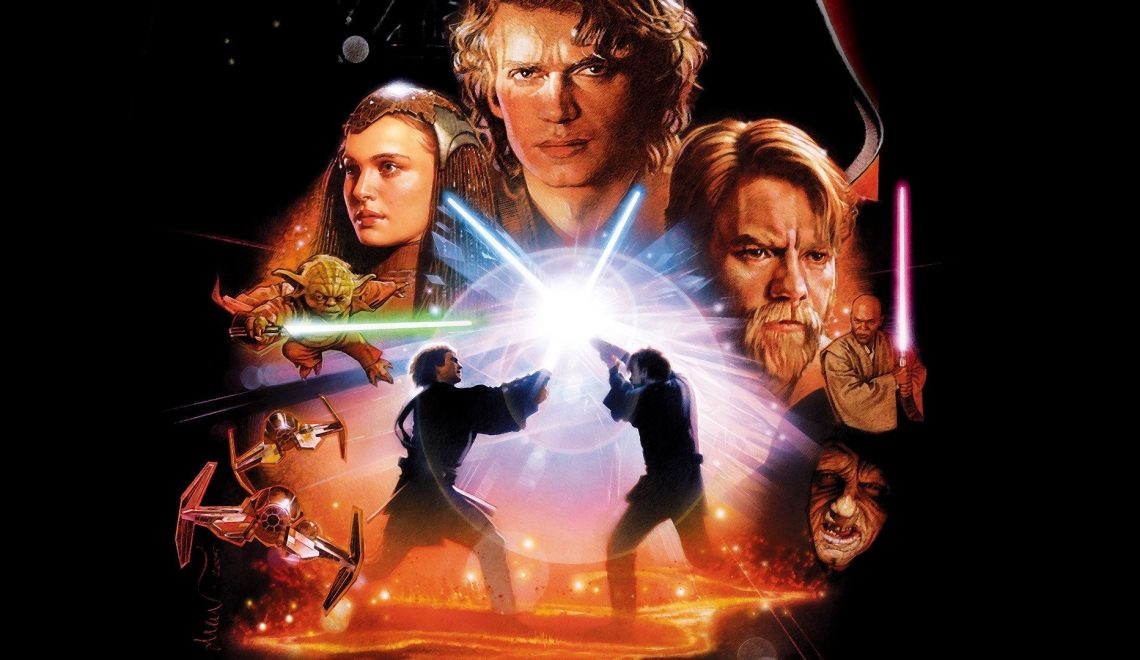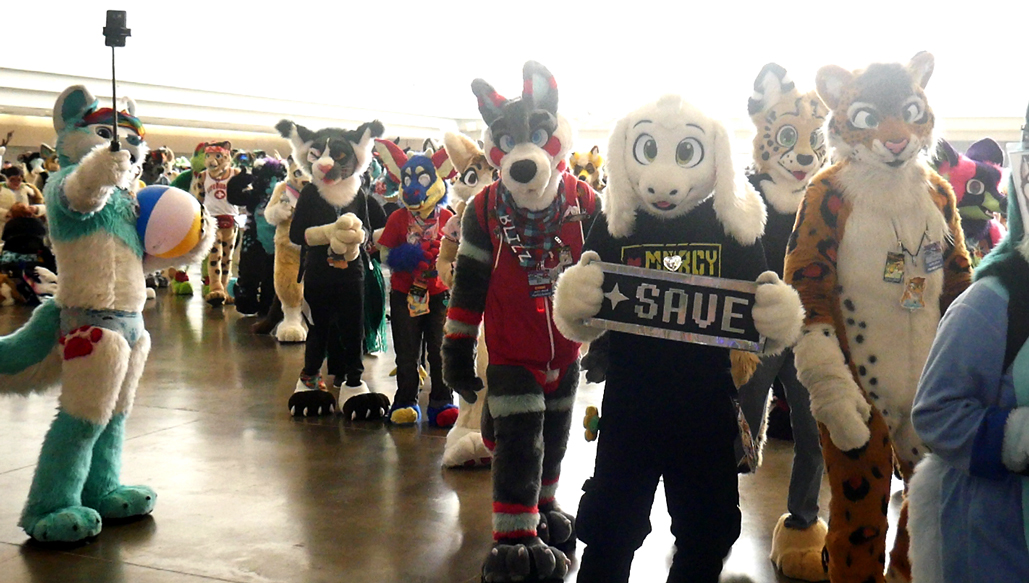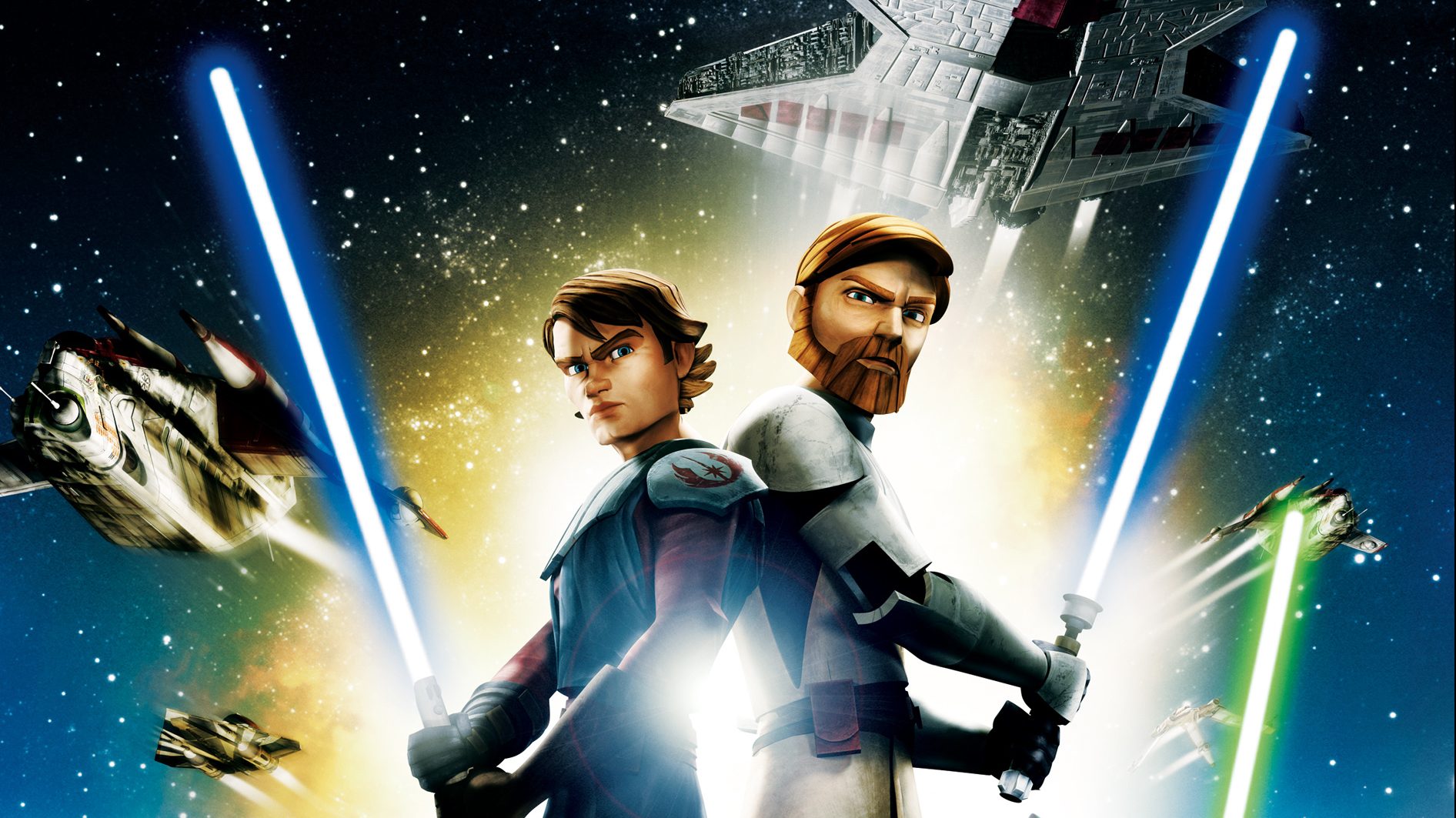
Wait, no video games? Yep. Let’s talk Star Wars and get a bit controversial.
The amount of vitriol spat toward George Lucas’ second trilogy of Star Wars films is overblown. While people may curse them as though they’re despicable as Hutts or worst than Bantha poodoo, you’ve got to give credit where credit is due. Yes, a lot of the writing and pacing is terrible. Time invested in key characters feels inadequate and wasted. The action sequences can be too self-indulgent with CGI or guided by over-the-top, flashy choreography. These are among a few major faults I came to form with later viewings of the prequels in my life, but I still admire the beautiful worlds and cities that Lucas crafted. I adore the history behind them, all the new aliens, and seeing how the Jedi Order looked and operated during the Republic. Heck, even though Lucas’ ineptitude for good scripts and character development resonate throughout Episode III, it remains one of my favorite Star Wars movies for its thrilling action, phenomenal score, dark tone, and improved drama.
I could keep teetering on this seesaw of criticism listing my likes and dislikes about the films, but that’s not what I want to explicitly dwell on. Let’s talk about The Clone Wars and how it’s a TV show that went beyond expounding on the prequels’ positive elements. It enthusiastically embraced the films by expanding and improving upon everything, even with concepts and characters you might find unsavory.
I do acknowledge the sad passing of Clone Wars (“The” is the distinction) being revoked from the canon to make way for this show, which was an incredible cartoon in its own right by the creators of Samurai Jack that featured some fantastic animation and scenes, from the visceral lightsaber fight between Anakin and Asajj to the chilling, allegorical prophesy of Darth Vader. With that being said, The Clone Wars rose in its place in 2008 with an unconventionally sporadic storyline and good animation with quirks in the characters’ motions and facial expressions, but it had loads of potential. After six seasons of 129 episodes that ended over two years ago, I can confidently say that the studio’s skills soared to remedy their original missteps. With the advent of Season 3, I think that’s when the show really came into its own as a force to be reckoned with. But how is it dark and mature as people like to say? Why is it so appealing and enjoyable? Having dropped off after Season 3 for no reason other than laziness several years ago, I restarted late last year and finished every season sometime in February. Here’s what I came away with from Star Wars: The Clone Wars.
Keep in mind that I attempt to avoid major spoilers for episodes by revoking names and being vague about plot points, so no need to worry about blatant spoilers here.
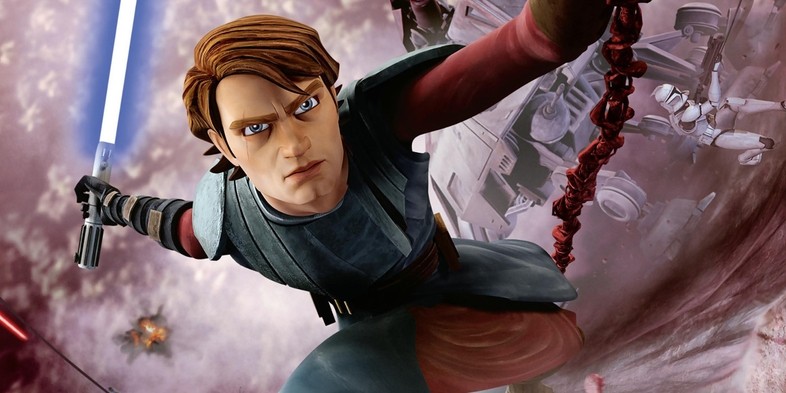
Anakin Skywalker is better handled and portrayed, being more likeable & relatable than his movie counterpart
Hayden Christensen gets a bad rap, and while I’m inclined to cringe along with everyone else to acting like this, I still think it’s more a matter of bad writing and direction than his own talents. He’s a phenomenal actor in other films such as Shattered Glass, so it’s a shame that Anakin comes across as unlikeable to me because of his constantly pouty and creepy behavior in Episode II. He’s not a protagonist you can connect with because he’s so easy to find annoying. How about an evidently good-natured, humorous guy visibly wrestling with anger, impatience, obedience, and lust that threaten to topple his normal behavior at a moment’s notice? That’s the Anakin I want to see, and that’s what The Clone Wars has on offer. While I’m glad we got more of a dark, brooding version of him in Episode III to solidify his descent toward the Dark Side, the show is where he truly shines.
Whereas the Anakin we know in the movies was typically serious, edgy, and even flat, this one is a surprisingly chipper, wisecracking Jedi. He still disobeys orders, but does so more out of passionate, well-reasoned conviction than childish spite. We even see a side to him that isn’t explored in the movies as a charismatic, inspiring leader of Clone armies. Full of brilliant ideas and risky strategies, Anakin shows that he can get results not only on the battlefield, but also in the air/space. It directly shows us why Darth Vader is a feared military commander (not just a ruthless warrior) in the Empire. This carries over into the novel Tarkin, where the eponymous Grand Moff works alongside Vader and is deeply impressed by his ingenuity as a tactician. He even notices how similar this brazen leadership is compared to a particular Jedi he knew during the Clone Wars…
However, what I love most is how the show deals with Anakin’s weaknesses. Instead of expecting him to throw a fit or nasty line at someone due to his continually negative attitude in the movies, he will suddenly revert from being a smiling, rational person to a calculating, disturbing villain in the show depending on what goes on around him. He Force chokes Poggle the Lesser (among numerous other victims) behind his fellow Jedi to gain important information. He devolves into pure hatred during one episode upon discovering Zygerrian slavers are involved in a Separatist plot, who are the species that enslaved his mother. On another occasion, two characters are faced with respective moral dilemmas of killing a certain villain, but Anakin doesn’t think twice about it, impaling the traitor through the heart without a care.
There’s so much to love about Anakin here. He truly is the “good friend” Obi-Wan Kenobi alludes to on Tatooine while reminiscing with his son. Their friendship is even more compelling and powerful in the show. Anakin’s impact on his Padawan Ahsoka, other Jedi, his most trusted Clones…they truly respect and enjoy being around him, which makes their concern and astonishment at his outbursts all the more understandable since you will react the same way! From beginning to end, you see so much light and genuine good in The Chosen One. It’s why the looming days of his troubled, distant state in Episode III seem sadder as we see more of Vader and less of Anakin as the days become darker after every season.

Existing characters & newcomers are given ample attention, making the Star Wars universe all the more diverse and rich
When you think about it, characters like Mace Windu, General Grievous, Bail Organa, Darth Maul, Jar Jar Binks…they didn’t really have that much character development in the movies, and in some cases, none at all. Audiences are left wondering about their histories, other facets of their personalities, and their relationships to other characters. It’s a good thing that The Clone Wars takes all of the aforementioned and more by giving them concrete places and identities in the Star Wars universe. You may balk at the idea, but Jar Jar is a great example. Several episodes revolve around him, and wherever he goes, his oblivious antics will get him in trouble and somehow out of it again, no matter the situation. The problem with Episode I is that Jar Jar’s unique presence felt disruptive with the other characters, only meant to appeal to juvenile audiences for cheap goofs and laughs. In The Clone Wars, the writers work with this tone he sets by isolating his arcs to suit more light-hearted stories, and if he’s roped into more serious matters, other characters actually acknowledge his annoying, unpredictable nature and dread what could happen with him around (but they’re still very forgiving of him). Two episodes involve him teaming up with Mace Windu to stop a cult fulfilling a dark prophesy. Yes, this actually happens, and the ways in which the two characters converse and work together to save the day brings out sides of them we rarely see. The writers play to these characters’ strengths and weaknesses with smart writing that benefits both of their development. They don’t take the easy routes of rewriting Jar Jar or not using him. Anything canon is game, even the tough material to work with, and this show isn’t afraid to approach it.
This goes for obscure side characters and newcomers as well. Aurra Sing is a pale white bounty hunter that only appears for a couple seconds in Episode I. She’s the one with the tight orange suit and metal antenna sticking out of her head. Despite her insignificant appearance in the film, she’s in multiple episodes throughout most of the seasons, revealing herself to be a chilling, cold-blooded killer who uses her charm and devious sniping skills to respectively seduce and strike down her targets. She’s even given a crucial role in Boba Fett’s development as a bounty hunter, and serves other villains throughout the show like the notorious Cad Bane, who’s an entirely new character worthy of his own paragraph.
There are so many new characters like Cad that enliven the universe with captivating personalities that shape the fate of the Clone Wars. However, I would be remiss to not at least devote some time to the beloved Ahsoka. Padawan to Anakin Skywalker, this young Twi’lek has arguably reached popularity heights comparable to Thrawn and Darth Bane for characters completely outside the movies. Her infectious charm, eager enthusiasm, and rebellious nature made her the perfect complement to Anakin as they learned from each other’s achievements and missteps. Her growth in wisdom and level of maturity are palpable as the show progresses, but what makes her most interesting as a Padawan is that while she overcomes many of her own demons, she begins to notice over time from her master that he’s…different. She loves him as a true friend, but subtly becomes more concerned as she understands him more through her independence. What’s so crucial as well is that her presence in Anakin’s life has a tremendous impact on him, even though he tried to reject her from the start. So, he fell to the Dark Side because of his undying love for and devotion to Padmé. He takes the same approach to his other relationships, and near the end of The Clone Wars, something happens between Ahsoka and him that gives profound explanation to his darkness and willingness to do anything for those he loves. She may not be mentioned in Episode III, but it all makes sense once you finish the show and realize how much depth her existence adds to Anakin’s tragic downfall.

Clone Troopers are given the chance to shine & present fascinating opportunities for philosophical questions, moral quandaries, & emotional moments
There’s a Clone Trooper named Fives. In snippets throughout the entire length of the show, you follow his journey from an unpromising Clone Cadet to an Arc Trooper willing to sacrifice everything for his brothers and the Republic, even if it means betraying them. He’s the quintessential figure that highlights the care put toward humanizing and deepening these soldiers in the show, which get lost in a sea of similar faces and voices in the films. The thrill of battle in “Landing on Point Rain”; the sheer drama and maturity of “Rookies”; the devastation of war made manifest in “Innocents of Ryloth”: these are episodes that have Clones at their finest and lowest, and either way, there’s little chance you won’t become attached to some of them.
Most episodes with a focus on Clones usually ended up being my favorites, such as “The Deserter.” It’s an episode about Captain Rex being wounded and having to seek the help of locals on a planet to recover. Little does he know that the Twi’lek that has taken in him is married to a Clone! He abandoned his brothers because he believed that he had the right to live his own life, rather than being forced into a form of slavery for the Republic’s war. This clashes with Rex’s ideals of camaraderie and sticking to the purpose they were created for: to serve and protect the Republic. It’s a fascinating episode that is shockingly philosophical and political, which will make viewers even apply this situation to real-world circumstances, perhaps in parallel to those who refused to answer the draft during the Vietnam War.
One of the finest and longest arcs starts with “Darkness on Umbara,” which begins like most of the action-centered episodes. However, when Jedi General Krell steps in for Anakin to command a group of Clones (which Fives and Rex are a part of!), they start to question their duties when the ruthless Krell acts recklessly by putting lives on the line for no reason. Should they mutiny and turn against him? Should they continue to obey him as Clones needlessly die with strategies they know won’t work? The internal conflicts among this battalion as they debate and diverge in opinion will make you pay attention to every moment, not wanting to stop the story arc until it concludes with the fourth episode. What makes them all so exciting is not so much the action, even though it is exceptional, but the drama behind the lines that lead to shocking decisions and revelations that make it a military story of worth, whether it were fictional or not.
There are so many more episodes I could point to that make efforts to make every Clone unique with their looks and personalities so you know who to keep track of and invest in. Just like Fives, you partake in an epic war story that stretches across the stars and planets, shaping and molding not only the Clones’ perceptions of themselves, but also your perceptions of them. They are individuals. They are soldiers. They are human beings, and the show wants to make all of these points clear in its fine-tuned attention toward them, which makes Order 66 so much more heart-breaking when you think about it. The moment Emperor Palpatine executed it, it wasn’t only the Jedi that were killed. The Clones died with them in spirit as their true memories, spirits, and convictions were washed away.
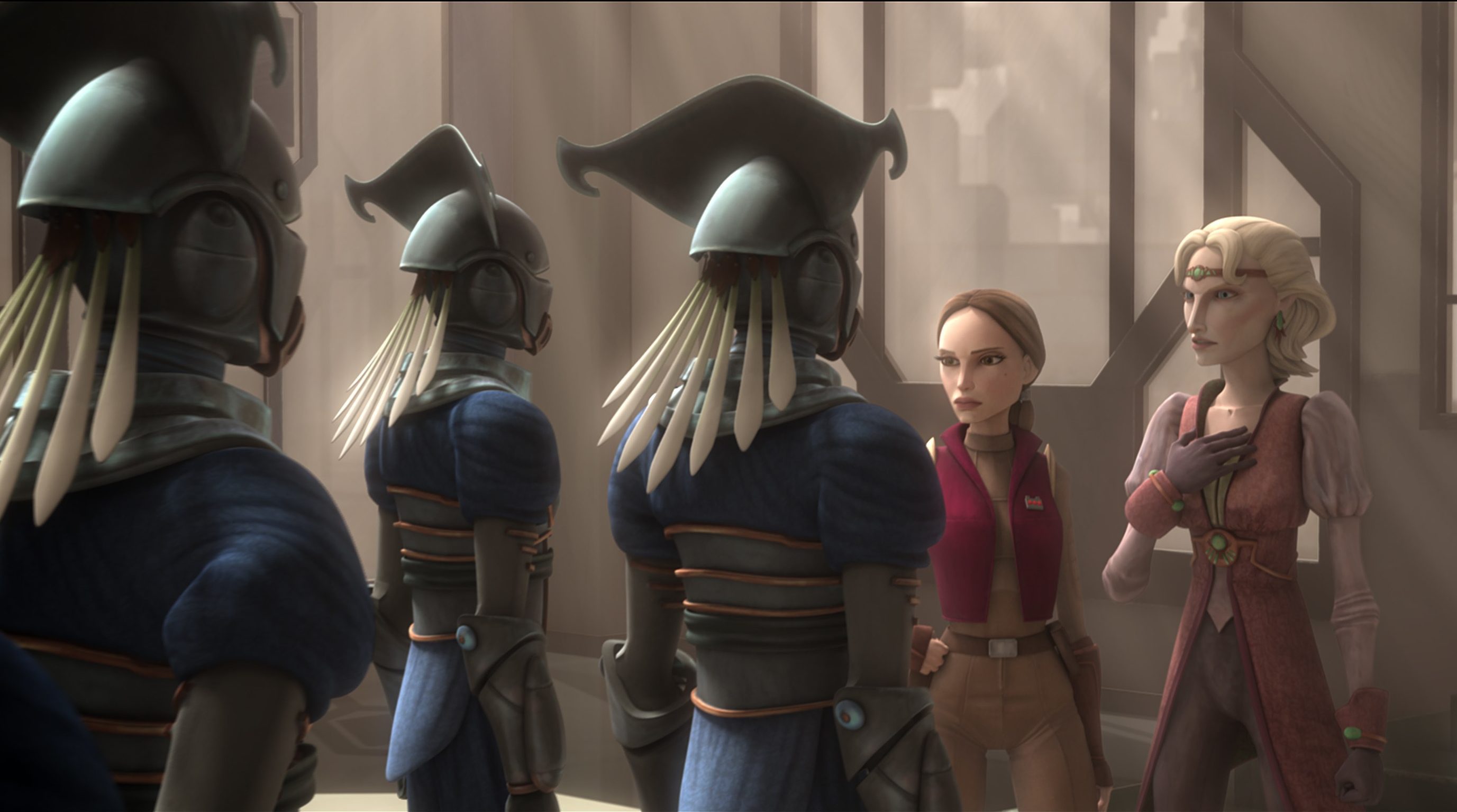
The politics provide drama and pacing the prequels cannot match in scope, which reveal the show’s capability to enthrall even with typically boring subjects
Mostly everyone agrees that the “trade negotiations” in Episode I are poorly set up. Instead of giving audiences good reasons to emotionally invest in the political turmoil brewing between the Separatists and Republic, it’s merely treated as a backdrop for exposition dumps. It doesn’t help that Queen Amidala ironically makes the robotic exchanges about politics more, well, robotic. If you want to make a political thriller of a story, you need to have stakes with characters you care about that are intimately linked to a controversy that will be affected by the outcome. You need insight into both sides to see the complexity of an issue at hand. You should make the actual debates themselves between politicians inflamed with passion and heat! You would think a show geared toward young audiences wouldn’t dare touch this realm, but The Clone Wars does. And guess what? It does so with grace and intelligence.
In the middle of the Clone Wars, viewers are invested in the war and the general picture of what’s going on, so issues pertaining to it in the Senate are sure to garner your interest in how everything progressed to Revenge of the Sith with Palpatine weaving his control over the Republic ever so subtly. We see this when we’re given a deep look at both sides advocating for and against the production of more Clones. There’s emotion and morality made evident here, and things get even worse when a close friend of Padmé is murdered for his opposition to the proposal, which he shared with her. We get to go behind the scenes with a good (albeit simple) murder mystery that’s right beneath all the pontificating and fancy ruses politicians put on with the job. Another episode has the tough senator advocating for the rights of war refugees on Alderaan, and while that reveals more of the political climate beyond the battlefield, the central excitement centers around Ahsoka and her visions of an assassin killing Padmé. These episodes add external drama that ties to the political conflicts in compelling ways.
There are even moments centered around humanizing proponents of the Separatists. “Heroes on Both Sides” has Ahsoka flipping her worldview upside down when she meets Lux: the son of a Separatist politician that Padmé is friends with. The young Jedi is originally disgusted at the senator, but comes to see from her conversations with and observations of the opposition that everything isn’t black and white, which intimately ties to her future philosophy as a “Jedi.” Again, it’s another backdrop to the main issue of seeking peace amidst insufficient war funds, a never-ending war, and so forth with the Republic. Double-crossing, hostage crises, sabotage, moral quandaries: these are all energies swirling within the politics of the show, whether it be in the Senate or the battle between cultural tradition and societal evolution with Mandalore’s government (that’s another example worthy of a whole other paragraph, too!).

The nature of The Force is heavily explored with grand allegories and wrinkles in how we understand it
“The Force is what gives a Jedi his power. It’s an energy field created by all living things. It surrounds us and penetrates us. It binds the galaxy together.”
Most complain about Midi-chlorians and how they ruined the spiritual quality of The Force, but I never felt like this biological component to how it works through living beings conflicted with the mystic view. However, the basic exposition explaining how the cells worked was understandably out of nowhere in Episode I. What in the world are these microscopic organisms? Why do they reside in all life forms, and how do they even relate to a cosmic power? The Clone Wars tells you, and in the process of doing that, manages to unravel some of that convolution to make The Force more complex and interesting.
I think the point where this is first accomplished is the Mortis arc. It involves Anakin, Obi-Wan, and Ahsoka answering an ancient Jedi distress call, and when they arrive, they are transported to a world where The Force is impossibly concentrated, even shaping the environments and weather to reflect a tumultuous balance between the Light and Dark Sides. The reason for this is that mysterious beings called The Ones live here, with the Son representing the Dark Side, the daughter the Light Side, and the Father the balance between them. They are not mere visions, but practically deities that are living parallels to The Force, which is understood through their immense power and abilities that go far beyond what most Jedi or Sith could do. Our trio of heroes discover so much about what The Force is about through these characters, and you will as well with the cryptic language and messages that further detail what being The Chosen One means for Anakin, why their must be balance in The Force, and so on.
There’s even distortion and corruption of it with the Nightsisters: a coven of Dathomirian females led by Mother Talzin who use their Force sensitivity in blasphemous manners. They practice a bastardization of the Dark Side with “Magicks,” which can distort reality and matter itself with devilish incantations and rituals. The scenes where this dark art is shown are so interesting to observe, because they bring a new layer to The Force that hasn’t been seen before. Perhaps the Light Side can be manipulated in other ways as well? Are there different Sides to The Force you haven’t even considered? You start to ask questions, but thankfully, The Clone Wars doesn’t leave you hanging all of the time. In fact, it literally ends on a story arc that answers profound questions relating to The Force and a crucial mystery pertaining to why Yoda and Obi-Wan were able to become Force Ghosts.
Yoda is the central character, and I honestly don’t want to say much about his tale because you must see it for yourself. You’re given glimpses into the origins of The Force and Midi-Chlorians. You see Yoda go through arduous trials that test his understanding and beliefs about The Force. You get a clear picture of how the Living Force and the Cosmic Force intersect and relate to one another. The former feeds the energy and power of living beings to the latter, so when the “Living Force” is strong and active in the galaxy, the “Cosmic Force” is vibrant and more easily felt. It makes Episode VII’s title seem all the more appropriate within this context! Yoda understood this in the show, and all we have to do is look to Episode V to see that the seemingly bad divide between Midi-Chlorians and the mystical aspect of The Force can be reconciled.
“Life creates it. Makes it grow. Its energy surrounds us and binds us. Luminous beings are we, not this crude matter. You must feel The Force around you! Here, between you, me, the tree, the rock. Everywhere. Yes, even between the land and the ship.”
Huh. Sounds familiar.
People talk about how this show is a mature, dark take on Star Wars that’s cut from the same, high-quality fabric as the original trilogy, but how? In reflection on my points (of which there are a few more I could list with plenty more examples, I assure you), it’s simply because the people who made the show – the writers, animators, directors, voice actors, designers – believe that Lucas’ universe is ripe for brilliant, new stories that could not only bring entirely new elements to the universe, but expand and improve upon his own work. Whenever I get into a discussion about the prequels with someone, I always say how Lucas is a great visionary. His creativity knows no bounds, but he needs direction. Episodes III and IV are when he was at his highest peaks at the helm, but it’s people like (especially) Irvin Kershner and Richard Marquand that were able to bring his stories to life in (arguably) the best ways possible. Lucas is at his best when he’s an advisor or writer since he became too controlling with how he saw things in the prequels. He has incredible ideas, but it takes the right people to build them up, and The Clone Wars is a perfect illustration. It’s no wonder that this is one, small part of why the show excelled, and you can tell Lucas’ legacy and influence lives on today through Rebels and it’s exceptional quality not only in storytelling, but imagination as well.
To go back and watch where that came from? You have to watch Star Wars: The Clone Wars. It is your destiny.

